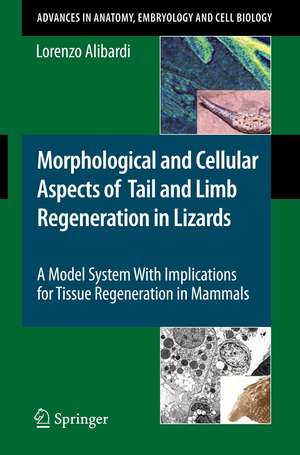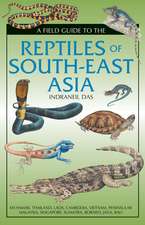Morphological and Cellular Aspects of Tail and Limb Regeneration in Lizards: A Model System With Implications for Tissue Regeneration in Mammals: Advances in Anatomy, Embryology and Cell Biology, cartea 207
Autor Lorenzo Alibardien Limba Engleză Paperback – 18 dec 2009
Din seria Advances in Anatomy, Embryology and Cell Biology
- 5%
 Preț: 1146.33 lei
Preț: 1146.33 lei - 5%
 Preț: 721.19 lei
Preț: 721.19 lei - 15%
 Preț: 637.13 lei
Preț: 637.13 lei -
 Preț: 381.81 lei
Preț: 381.81 lei - 15%
 Preț: 644.95 lei
Preț: 644.95 lei - 5%
 Preț: 1025.16 lei
Preț: 1025.16 lei - 15%
 Preț: 689.97 lei
Preț: 689.97 lei - 15%
 Preț: 577.07 lei
Preț: 577.07 lei - 15%
 Preț: 580.36 lei
Preț: 580.36 lei - 5%
 Preț: 393.51 lei
Preț: 393.51 lei -
 Preț: 408.66 lei
Preț: 408.66 lei -
![Die Schlüpfdrüse der Geburtshelferkröte (Alytes o. obstetricans [LAURENTI]) und anderer Froschlurche](https://i4.books-express.ro/bs/9783662239742/die-schluepfdruese-der-geburtshelferkroete-alytes-o-obstetricans-laurenti-und-anderer-froschlurche.jpg) Preț: 408.27 lei
Preț: 408.27 lei - 5%
 Preț: 1090.61 lei
Preț: 1090.61 lei - 5%
 Preț: 705.11 lei
Preț: 705.11 lei - 5%
 Preț: 706.04 lei
Preț: 706.04 lei - 5%
 Preț: 357.61 lei
Preț: 357.61 lei - 5%
 Preț: 704.59 lei
Preț: 704.59 lei - 5%
 Preț: 705.11 lei
Preț: 705.11 lei - 5%
 Preț: 359.42 lei
Preț: 359.42 lei - 5%
 Preț: 711.52 lei
Preț: 711.52 lei - 15%
 Preț: 635.47 lei
Preț: 635.47 lei - 15%
 Preț: 631.72 lei
Preț: 631.72 lei - 15%
 Preț: 633.35 lei
Preț: 633.35 lei - 15%
 Preț: 632.37 lei
Preț: 632.37 lei - 5%
 Preț: 706.60 lei
Preț: 706.60 lei - 15%
 Preț: 631.07 lei
Preț: 631.07 lei - 5%
 Preț: 707.13 lei
Preț: 707.13 lei - 5%
 Preț: 707.33 lei
Preț: 707.33 lei - 5%
 Preț: 359.60 lei
Preț: 359.60 lei - 5%
 Preț: 707.69 lei
Preț: 707.69 lei - 5%
 Preț: 707.13 lei
Preț: 707.13 lei - 5%
 Preț: 708.06 lei
Preț: 708.06 lei - 5%
 Preț: 706.41 lei
Preț: 706.41 lei - 5%
 Preț: 708.78 lei
Preț: 708.78 lei - 5%
 Preț: 705.68 lei
Preț: 705.68 lei - 5%
 Preț: 705.11 lei
Preț: 705.11 lei - 5%
 Preț: 706.77 lei
Preț: 706.77 lei - 15%
 Preț: 635.15 lei
Preț: 635.15 lei - 15%
 Preț: 631.07 lei
Preț: 631.07 lei - 5%
 Preț: 706.77 lei
Preț: 706.77 lei - 5%
 Preț: 706.04 lei
Preț: 706.04 lei - 5%
 Preț: 710.79 lei
Preț: 710.79 lei - 5%
 Preț: 705.32 lei
Preț: 705.32 lei - 15%
 Preț: 633.19 lei
Preț: 633.19 lei - 15%
 Preț: 629.09 lei
Preț: 629.09 lei - 15%
 Preț: 633.53 lei
Preț: 633.53 lei - 15%
 Preț: 632.70 lei
Preț: 632.70 lei - 15%
 Preț: 633.68 lei
Preț: 633.68 lei - 18%
 Preț: 773.72 lei
Preț: 773.72 lei - 15%
 Preț: 630.43 lei
Preț: 630.43 lei
Preț: 710.79 lei
Preț vechi: 748.20 lei
-5% Nou
Puncte Express: 1066
Preț estimativ în valută:
136.01€ • 142.30$ • 112.98£
136.01€ • 142.30$ • 112.98£
Carte tipărită la comandă
Livrare economică 02-16 aprilie
Preluare comenzi: 021 569.72.76
Specificații
ISBN-13: 9783642037320
ISBN-10: 3642037321
Pagini: 128
Ilustrații: XII, 112 p. 28 illus., 8 illus. in color.
Dimensiuni: 155 x 235 x 7 mm
Greutate: 0.3 kg
Ediția:2010
Editura: Springer Berlin, Heidelberg
Colecția Springer
Seria Advances in Anatomy, Embryology and Cell Biology
Locul publicării:Berlin, Heidelberg, Germany
ISBN-10: 3642037321
Pagini: 128
Ilustrații: XII, 112 p. 28 illus., 8 illus. in color.
Dimensiuni: 155 x 235 x 7 mm
Greutate: 0.3 kg
Ediția:2010
Editura: Springer Berlin, Heidelberg
Colecția Springer
Seria Advances in Anatomy, Embryology and Cell Biology
Locul publicării:Berlin, Heidelberg, Germany
Public țintă
ResearchCuprins
Regeneration in Reptiles and Its Position Among Vertebrates.- Tail Regeneration: Ultrastructural and Cytological Aspects.- Limb Regeneration: Ultrastructural and Cytological Aspects.- Conclusion and Perspectives: Implications for Human Regeneration.
Recenzii
From the book reviews:
“This is an exploration into the controversies about amphibian/mammalian limb regeneration. … I recommend this book for developmental biologists, orthopaedic surgeons, students, and fellows with interests in the molecular, cellular, and tissue aspects of regeneration.” (Joseph J. Grenier, Amazon.com, August, 2014)
“This is an exploration into the controversies about amphibian/mammalian limb regeneration. … I recommend this book for developmental biologists, orthopaedic surgeons, students, and fellows with interests in the molecular, cellular, and tissue aspects of regeneration.” (Joseph J. Grenier, Amazon.com, August, 2014)
Textul de pe ultima copertă
The present review deals with the analysis of the cytological processess occurring during tissue regeneration in the tail and limb of lizards. These reptiles are considered as a model to understand the process of tissue regeneration in all amniotes. The review begins with some evolutive considerations on the origin of tail regeneration in comparison to the failure of limb regeneration, a unique case among amniotes. The formation of the tail in the embryo and the possible accumulation of stem cells in autotomous planes of the tail are discussed. The histological and ultrastructural processess occuring during blastema formation and tail regeneration and during limb cicatrization are presented. The comparison stresses the scarse to absent inflammatory reaction present in the tail vs the massive inflammatory response in the limb leading to scarring. In fact the experimental induction of a strong inflammation in the tail also leads to scarring. The importance of the nervous system in stimulating tail regeneration in lizards is emphasized. The presence of growth factors and extracellular matrix proteins during wound healing of the tail and limb is introduced. The review concludes stressing the importance of the lizard model of tissue regeneration for medical studies and applications.
Caracteristici
Includes supplementary material: sn.pub/extras







